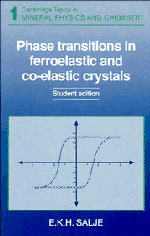Book contents
- Frontmatter
- Contents
- Errata
- Preface
- A brief guide for the reader
- 1 Introduction and some definitions
- 2 Ferroelastic and co-elastic phase transition
- 3 The Landau potential
- 4 The spontaneous strain
- 5 Coupling between the spontaneous strain and the order parameter
- 6 Macroscopic classification of ferroic and co-elastic crystals
- 7 Ferroelastic and co-elastic twin structures
- 8 Domain mobilities and elastic instabilities in ferroelastic and co-elastic materials
- 9 Specific heat anomalies and the excess entropy
- 10 Coupling between order parameters in ferroelastic and co-elastic crystals
- 11 Gradient coupling and strain modulations
- 12 Some aspects of the kinetic behaviour of ferroelastic and co-elastic crystals: an outlook
- References
- Appendix: An atomistic model for the Landau potential and the origins of the saturation effect
- Index
6 - Macroscopic classification of ferroic and co-elastic crystals
Published online by Cambridge University Press: 03 May 2011
- Frontmatter
- Contents
- Errata
- Preface
- A brief guide for the reader
- 1 Introduction and some definitions
- 2 Ferroelastic and co-elastic phase transition
- 3 The Landau potential
- 4 The spontaneous strain
- 5 Coupling between the spontaneous strain and the order parameter
- 6 Macroscopic classification of ferroic and co-elastic crystals
- 7 Ferroelastic and co-elastic twin structures
- 8 Domain mobilities and elastic instabilities in ferroelastic and co-elastic materials
- 9 Specific heat anomalies and the excess entropy
- 10 Coupling between order parameters in ferroelastic and co-elastic crystals
- 11 Gradient coupling and strain modulations
- 12 Some aspects of the kinetic behaviour of ferroelastic and co-elastic crystals: an outlook
- References
- Appendix: An atomistic model for the Landau potential and the origins of the saturation effect
- Index
Summary
Some common definitions: necessary, useful but very dry.
Phase transitions accompanied by a change of the point-group symmetry are called ferroic. Ferroic phase transitions are often subdivided into ferrodistortive, i.e. where the translational symmetry is preserved during the phase transition, and antiferrodistortive where such an invariance does not exist. In the language of group theory it means that the active irreducible representation has Г- point symmetry (k=0) in the case of a ferrodistortive phase transition, whereas it transforms with a finite k-vector for all other transitions. This k-vector is called critical: the critical k-vector is at special points of the boundary of the first Brillouin Zone for antiferrodistortive phases and inside the Brillouin Zone, but not at its origin, for modulated phases. Various aspects of these symmetry relationships were discussed within the framework of Landau theory by Toledano and Toledano (1980), Stokes and Hatch (1988), Janovec (1976) and many other authors. These symmetry considerations are useful for classification purposes, but they do not necessarily always help to elucidate the underlying physical properties which actually drive the transition mechanisms. The reason for this is that, usually, several physical processes combine to lower the Gibbs free energy so that the low-symmetry phase becomes thermodynamically stable. Typical examples are combinations between electric and elastic degrees of freedom (e.g. Suzuki and Ishibashi 1987), molecular ordering and co-elasticity (Lynden-Bell et al. 1989) and cation ordering and ferroelasticity (e.g. Salje 1985; and many others).
- Type
- Chapter
- Information
- Publisher: Cambridge University PressPrint publication year: 1991



